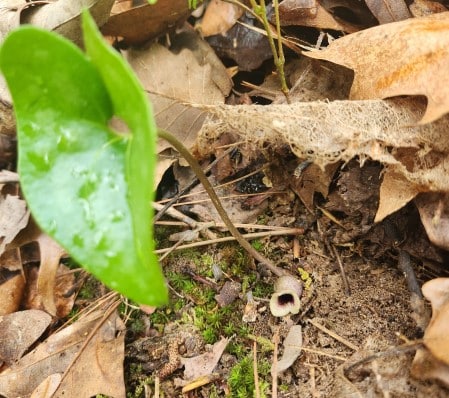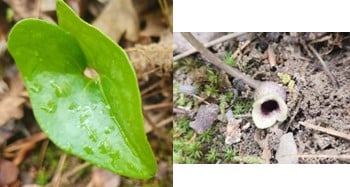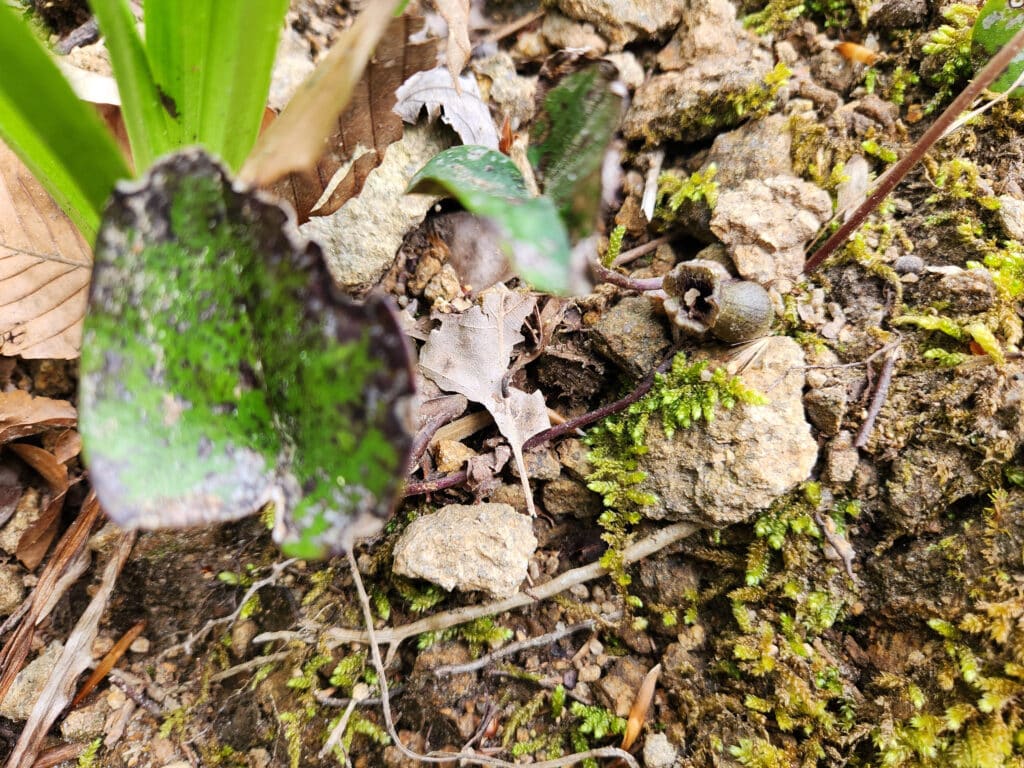
Many gardeners out there are entering their busy season, as fall is the perfect time to install new vegetation in gardens and natural landscapes. Utilizing species native to a particular area and making sure they are the appropriate ecotype of that species is increasing in popularity amongst gardeners. Native plant gardens tend to exhibit large and/or colorful species of flowers, shrubs, and vines, while overlooking some of the less-flashy plants present in our state. One such North Carolina plant is Hexastylis arifolia, otherwise known as the little brown jug. This low-to-the-ground herbaceous perennial is often overlooked on woodland hikes, as the flowers are not particularly eye-catching. Those that notice it may confuse this species with wild ginger, Asarum canadense, which is in the same family, but has deciduous leaves, whereas little brown jug is an evergreen.

Photographs of the foliage and flower of Hexastylis arifolia by Reina Kornmayer
Little brown jug has triangular to arrow-shaped leaves that are leathery in texture and release a spicy odor when torn. This species was used as a ginger substitute by early settlers, and local indigenous tribes used extracts and infusions from the leaves and roots to treat respiratory ailments and heart problems. This plant gets its name from its flowers, which are jugs often hidden beneath the leaf litter due to their short stems and rhizomes. These small, urn-shaped flowers grow to be about an inch long, are in bloom from March through May, and can be brown, green-brown, or purple-brown on the outside and a dark purple-brown on the inside. If the flowers are right at ground level, and they are not brightly colored, how is this species pollinated? Well, that is where the weirdness begins!

Can you find the jug in the above image? Photograph of Hexastylis arifolia by Reina Kornmayer.
It was previously thought that both the Asarum genus and the Hexastylis genus were pollinated by carrion flies and fungus gnats. On the surface, this makes sense: the flowers of both genera are on the ground and are flesh-colored, matching the preferred foods of those groups of insects. However, research performed on wild ginger, Asarum canadense, since the 1980s has gathered evidence supporting the hypothesis that this species is self-pollinating. Fascinating information, you are probably thinking, but wasn’t this article about the little brown jug, and not its distant relative? Subsequent research on the Hexastylis genera has demonstrated that the distance between their anthers and stigmas in each flower is too great for self-pollination on their own. They need a little assistance, namely an insect one.
While wild ginger does not produce an odor, Hexastylis arifolia releases a very faint odor that resembles rotting flesh. Now, I have personally attempted to smell this odor on little brown jugs in the wild, and it is very hard to detect. You must get your nose at the right spot to smell the mild odor of decay. It is now thought that little brown jugs are pollinated by various species of carrion beetles. This group of beetle species spends its time on the forest floor searching for decaying flesh and poop in which to lay eggs; thus, the flowers of little brown jug would be easy to access. As these species excel at following scent trails to rotting refuse, they can easily locate these flowers. It is hypothesized that, once inside of the flower, the beetles move the pollen from the anther to the stigma while they scramble around, assisting the self-pollination process. So next spring, when you are taking a hike through a North Carolina forest, pay attention to the herbaceous plants along the forest floor. Chances are that the little brown jug is among them, waiting for a beetle to come along and pollinate one of their flowers. That, my friends, is one weird and wonderful plant!
